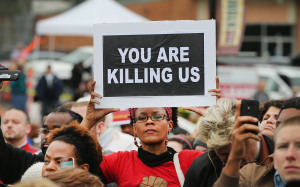Trump’s First Year Ends in Twice as Many Mass Shootings Than Obama’s!

Over the course of Trump’s first year in office a total of 112 people died in 10 separate mass shooting events. The list includes the nation’s deadliest attack in Las Vegas on October 1, 2017 which claimed 58 lives and injured over 800 victims.
These findings are rather acute for a President who ran on a pro-gun platform. Trump’s embrace of America’s biggest gun lobbying group, the National Rifle Association (NRA), was demonstrated in his speech last April where he became first President to publicly address the group since Ronald Reagan in 1983.
The advent of Trump’s Presidency followed one of the biggest booms in gun sales in American history. According to a Forbes report published in 2016, Obama’s tenure as President pushed firearm sales to a growth of 158%.[1] More than 157 million National Instant Criminal Background Checks (NICS), (a necessary procedure in most states for the procurement of firearms) were submitted between 2009-2016, a 45% increase over the Bush administration years.[2] Though the NICS statistics don’t provide the most accurate indicator for gun purchases, (since the data doesn’t account for rejected applications or where a person buys multiple firearms under one check), it is considered a worthy proxy for American domestic gun sales.
The reasons for the massive growth in gun sales during the Obama administration have been attributed to public fears for the tightening of gun laws. Media coverage of national debates on gun restrictions, spurred by the aftermath of mass shootings, have shown to prompt increases in gun purchases. A research study in California which tracked hand gun sales concluded that after the Newtown massacre in 2012 and the San Bernadino shooting in 2015 there was a noticeable spike in sales. The study also found that the “expected volume” across the state of California amounted to a 53% increase in handgun purchases after Newtown and 41% more handguns after San Bernadino.[3]
Despite the nod to pro-gun advocates, Trump’s promise to safeguard the interests of the Second Amendment has led to the first significant drop in NICS submissions in 14 years. As a result, major gun companies, such as Smith & Wesson and Sturm Ruger have both posted declining third quarter growth figures for July 2017 by 40% and 22% respectively.[4] This follows the latest announcement from fellow gun manufacturer Remington Outdoor, that it was filing for chapter 11 bankruptcy.
Coined the “Trump Slump,” the systemic decline in gun sales in 2017 has underlined an ironic phenomenon of the American gun market.
Both the Vegas shooting and the massacre that befell parishioners at the Baptist church in Sutherland Springs, Texas less than six weeks later, where 25 people were killed, (making it the 5th largest mass shooting in American history) did not prompt similar increases in gun sales as witnessed during the Obama era. This is also in the view that many of these victims were white and predominately Republican voters. It is worth noting that another occurrence was the Congressional baseball shooting in June 2017 where a gunman opened fire on several US Republican congressmen. None were killed.
This begs the question. In an era of continued heightened fear, why haven’t recent events provided the same incentive for increased gun sales, especially considering that the victims appear to be hailing from pro-gun Republican demographics?
The most obvious answer is that a pro-gun President like Trump does not ferment fears of future gun law restrictions exhibited by the previous administration. Ironically Obama, who made it a priority in his second term, never signed any measures that placed restrictions on gun owners. It was the habits of the Mass Media to over-saturate mass shootings events, which placed Obama’s threats at gun reform into the forefront.
So why then all the fuss from the gun manufacturers? The overall decrease in gun sales, while significant, doesn’t necessarily set an moribund trend for the industry. In fact, 2017 is still considered a strong year judging by historical standards.
It seems likely that the gun industry has been exaggerating or possibly embellishing their demise in order to gain attention. Similar cry wolf tactics had been used previously by defence contractors following the signing of the Budget Control Act in 2011 which placed a budget cap on the Pentagon.
Gun manufacturers like Smith & Wesson and Remington Outdoor are no doubt signalling the administration that a form of gun promoting legislation to prompt firearm sales is warranted. Whether it is through policies designed to promote responsible gun ownership or because of the recent school shooting in Florida, another threat towards gun control legislation similar to the attempts made by Obama, President Trump will need to pacify the concerns of the companies that employ much of his voting base.
*
Andre Bermont is a freelance writer and Editor-in-Chief for www.cuibononews.com. Andre can be reached at [email protected]
Notes
[1] Miniter, Frank, “The Gun Industry Says It Has Grown 158% Since Obama Took Office,” Forbes, April 12, 2016. https://www.forbes.com/sites/frankminiter/2016/04/12/the-gun-industry-says-it-has-grown-158-since-obama-took-office/#79c190ac7f4e
[2] NICS Firearm Background Checks: Month/Year, FBI Official Website, https://www.fbi.gov/file-repository/nics_firearm_checks_-_month_year.pdf/view
[3] Studdert, David, “Handgun Acquisition After Two Mass Shootings,” Annals on Internal Medicine, May 2, 2017. http://annals.org/aim/fullarticle/2624284/handgun-acquisitions-california-after-two-mass-shootings
[4] Mukherjee, Sy, “Why Donald Trump is Bad for Gun Sales,” Fortune, September 11, 2017. http://fortune.com/2017/09/11/trump-gun-sales-decline/

